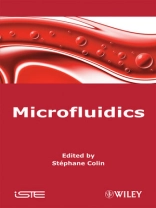The recent development of microscale technologies makes it possible to design complex microsystems devoted to transport, dosing, mixing, analysis or even synthesis of fluids. Applications are numerous and exist in almost every industrial field, from biotechnology and healthcare to aeronautics and advanced materials manufacturing. Microfluidics is a relatively new research area, usually comprising work with microsystems and involving internal fluid flows with characteristic dimensions of the order of one micrometer (1 x 10 ¯-6 m).
This book provides engineers and researchers with a range of tools for modeling, experimenting on, and simulating these microflows, as a preliminary step in designing and optimizing fluidic microsystems. The various consequences of miniaturization on the hydrodynamics of gas, liquid or two-phase flows, as well as on associated heat transfer phenonema, are analyzed.
The book is illustrated with examples that demonstrate the wide diversity of applications, and the breadth of novel uses of these fluidic microsystems.
Зміст
Preface xi
Chapter 1. Introduction to Microflows 1
Stéphane COLIN
1.1. Fluid mechanics, fluidics and microfluidics 1
1.2. Scaling effects and microeffects 3
1.3. Original pumping techniques 14
1.4. Microfabrication and flows 18
1.5. Microfluidic applications 20
1.6. Bibliography 21
Chapter 2. Gaseous Microflows 25
Jean-Claude LENGRAND and Tatiana T. ELIZAROVA
2.1. Continuum model and molecular model 25
2.2. Molecular description of a flow 38
2.3 Continuum description of a flow 51
2.4. Physical modeling 59
2.5. Examples of microflows 67
2.6. Bibliography 85
Chapter 3. Liquid Microflows: Particularities and Modeling
89
Christine BARROT and Jean-Pierre DELPLANQUE
3.1. Introduction 89
3.2. Background, liquid microflow physics 90
3.3. Numerical simulation of microflows 101
3.4. Non-mechanical active control of microflows 110
3.5. Conclusions 114
3.6. Bibliography 115
Chapter 4. Physiological Microflows 121
Jacques DUFAUX, Marc DURAND, Gérard GUIFFANT and Kristine
JURSKI
4.1. Description of the microvascular network 121
4.2. Blood flow: an unusual means of transportation 130
4.3. Instrumentation 141
4.4. Description of flows and microcirculatory networks 154
4.5. The microcirculatory system: an optimized transport
network? 174
4.6. Conclusion 186
4.7. Bibliography 186
Chapter 5. Single-Phase Heat Transfer 195
Sedat TARDU
5.1. Introduction 195
5.2. Heat transfer in channels of conventional sizes 196
5.3. ‘Macroeffects’ in microchannels: single-phase
liquid flows 201
5.4. Gas microflows: rarefaction and compressibility 211
5.5. Molecular effects of liquid flows in microchannels 220
5.6. Electrostatic effects: interfacial electrostatic double
layer 222
5.7. Conclusion 229
5.8. Acknowledgment 229
5.9. Bibliography 230
Chapter 6. Two-Phase Microflows 235
Olivier LEBAIGUE
6.1. Introduction 235
6.2. Digital versus continuous two-phase microflows 241
6.3. Basic phenomena 244
6.4. Some peculiarities of two-phase flows in microchannels
277
6.5. Bibliography 294
Chapter 7. Experimental Methods 303
Lucien BALDAS and Robert CAEN
7.1. Introduction 303
7.2. Measurements at the microscale: general overview 303
7.3. Pressure measurements 304
7.4. Flow rate measurements 309
7.5. Temperature measurements 326
7.6. Velocity measurements 328
7.7. Conclusion 340
7.8. Acknowledgments 340
7.9. Bibliography 340
Chapter 8. Fluidic Microsystems 349
Isabelle DUFOUR and Olivier FRANÇAIS
8.1. Introduction 349
8.2. Basic modules 349
8.3. Examples of developments around microsystems 365
8.4. Conclusion 382
8.5. Bibliography 382
Chapter 9. Microsystems in Macroflows Active Control
389
Sedat TARDU
9.1. Introduction 389
9.2. Notions of active control 390
9.3. Microsensors 395
9.4. Microprobes in the flow 421
9.5. Actuators 422
9.6. Conclusion 424
9.7. Bibliography 424
List of Authors 433
Index 435
Про автора
Stéphane Colin is Professor at the University of Toulouse, France. He is the co-chair of the first European Conference on Microfluidics, and coordinates a European training network on gas microflows.












